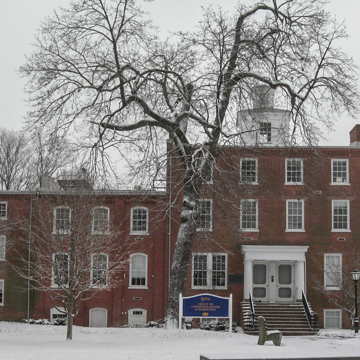Delaware Governor John Penn chartered the Academy of Newark in 1769, granting permanent status to a school founded by Dr. Francis Alison at his home in New London, Pennsylvania, in 1743. Academy Square was Newark's town marketplace (the markethouse was removed c. 1840), and proceeds from weekly markets and the annual fair were directed to constructing, in the late 1760s, a two-story stone schoolhouse on the site of the current building. In the struggle between Presbyterian factions, the Academy of Newark was promoted as a traditionalist “Old Side” rival to enthusiastic “New Side” Princeton University (see White Clay Creek Presbyterian, NK5). The splenetic Alison served as president of the Academy's board for the first decade. Eventually, the trustees applied for a state charter, granted in 1833; at that point, the institution split into a preparatory school and Newark College, today's university. Old College hall (NK9.1) was built across town for the latter. A few years later, the Academy Building was erected, an economical, cupola-topped brick edifice with a dormitory beside it, facing a lawn with trees. Edgar Allan Poe charmed an audience here at Christmastime 1843, lecturing on “American Poetry.” As Delaware College grew over the years, the Academy was overshadowed, and it closed in 1898. Today the building contains university offices.
You are here
Academy Building
If SAH Archipedia has been useful to you, please consider supporting it.
SAH Archipedia tells the story of the United States through its buildings, landscapes, and cities. This freely available resource empowers the public with authoritative knowledge that deepens their understanding and appreciation of the built environment. But the Society of Architectural Historians, which created SAH Archipedia with University of Virginia Press, needs your support to maintain the high-caliber research, writing, photography, cartography, editing, design, and programming that make SAH Archipedia a trusted online resource available to all who value the history of place, heritage tourism, and learning.


